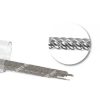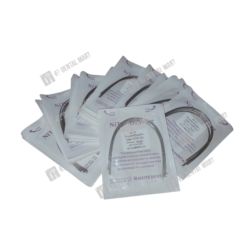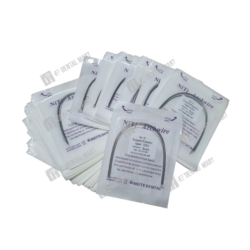Product Description
🦷 Uses of Coaxial Wire in Orthodontics:
-
Improved Control of Tooth Movement:
-
Coaxial wires are designed to apply different forces at different levels of the wire. The inner and outer layers of the wire provide varying degrees of flexibility and strength, allowing orthodontists to control tooth movement with more precision.
-
-
Space Closing:
-
The use of coaxial wire in space closure helps maintain controlled, gentle force while aligning the teeth. The wire’s design makes it especially useful in cases where space is being closed slowly over time.
-
-
Complex Orthodontic Movements:
-
Ideal for complex tooth movements, including rotation correction and intrusion or extrusion of teeth, as it allows for more precise, gradual adjustments.
-
-
Combination of Strength and Flexibility:
-
Coaxial wires combine the strength of a more rigid material (usually the outer layer) with the flexibility of a more flexible material (inner layer). This combination helps in achieving specific tooth movements without risking excessive force on delicate teeth.
-
-
Used in Finishing Stages:
-
In the final stages of orthodontic treatment, coaxial wire can be used to fine-tune tooth positions and achieve perfect alignment, improving the precision of the occlusion.
-
-
Torsional Control:
-
The coaxial structure allows for torsional control (control over twisting or rotating forces), which is especially helpful in correcting rotations or misalignments in the teeth.
-
-
Strength in Retention:
-
Coaxial wires can also be used in retention appliances to maintain tooth positions after the active treatment phase, providing both stability and flexibility in the retention phase.
-
-
Used in Specific Bracket Systems:
-
Some modern orthodontic systems use coaxial wires as part of their treatment plans, offering better control in cases where precise force application is needed.
-
✅ Benefits of Coaxial Wire in Orthodontics:
-
Precise Control of Tooth Movement:
-
Coaxial wire provides greater precision in tooth movement by combining different strengths and flexibilities from its concentric layers. This allows for more accurate adjustments and better control over complex tooth movements.
-
-
Improved Force Distribution:
-
The inner and outer layers of the coaxial wire provide differing force levels, allowing for controlled application of both light and strong forces to achieve specific movements. This helps in preventing unwanted movements while promoting optimal tooth positioning.
-
-
Enhanced Flexibility and Strength:
-
By combining flexibility (in the inner layer) and strength (in the outer layer), coaxial wire offers a balance of both resilience and adaptability, which is useful in various stages of treatment, especially for complex tooth movements.
-
-
Ideal for Finishing Stages:
-
Coaxial wire is often used during the finishing phase of orthodontic treatment to fine-tune tooth alignment, improving the precision of the final result by offering controlled, gradual movements.
-
-
Reduced Risk of Overcorrection:
-
Because the wire can apply a gentler, more controlled force, there’s a lower risk of overcorrection or applying too much force, making it a safer option for sensitive tooth movements or delicate adjustments.
-
-
Torsional and Rotational Control:
-
Coaxial wire is particularly effective for rotational corrections, providing precise torsional control over twisted or rotated teeth, which is crucial in cases with misalignments or crowding.
-
-
Versatility in Treatment:
-
Coaxial wire can be used in a variety of orthodontic cases, including space closure, crowding correction, and alignment of malocclusions, making it a versatile choice for different treatment goals.
-
-
Comfort for the Patient:
-
The controlled force and the nature of the coaxial wire help in ensuring a comfortable orthodontic experience, with less discomfort compared to more aggressive methods of tooth movement.
-
-
Helps Maintain Tooth Positioning:
-
It is also beneficial in retention phases, as it helps to stabilize the teeth once they’ve reached their desired positions, preventing shifting after treatment.
-
🔧 Features of Coaxial Wire in Orthodontics:
-
Dual-Layer Design:
-
Coaxial wire consists of two or more concentric layers (typically an outer layer and an inner layer), with each layer offering distinct properties. The outer layer is typically stronger and more rigid, while the inner layer is more flexible.
-
-
Strength and Flexibility Combination:
-
The outer layer provides strength and resilience, while the inner layer offers flexibility. This dual-layer structure allows the wire to apply both gentle and strong forces, enabling precise control over tooth movement.
-
-
Controlled Force Application:
-
The wire’s design allows for gradual, controlled force application, making it ideal for fine-tuning tooth positions, particularly during the finishing phase of treatment or for more complex tooth movements.
-
-
Torsional Control:
-
The coaxial wire offers superior control over rotational movements, making it particularly useful for correcting rotated teeth or managing torsional issues (twisting of teeth) in orthodontic treatment.
-
-
Customizable for Treatment Needs:
-
The wire is available in different diameters, strengths, and stiffness to suit specific treatment needs. The inner and outer layers can be customized to provide the appropriate force for a given stage of treatment.
-
-
Smooth Surface:
-
The wire typically has a smooth surface that helps reduce friction and minimizes irritation to the patient’s gums and soft tissues, improving comfort during treatment.
-
-
High Durability:
-
Coaxial wires are typically made from stainless steel or titanium, which makes them highly durable and resistant to corrosion, ensuring long-term effectiveness and stability during treatment.
-
-
Ideal for Complex Cases:
-
The coaxial wire design is particularly beneficial for complex orthodontic cases, such as cases involving severe rotations, crowding, or large gaps between teeth, where precise tooth movement control is essential.
-
-
Less Frequent Adjustments:
-
Due to its stable force delivery, the coaxial wire often requires fewer adjustments compared to other wire types, making it more convenient for both the orthodontist and the patient.
-
-
Versatile Application:
-
It can be used with a variety of bracket systems and archwires, making it highly versatile in orthodontic treatments, from space closure to finishing and bite correction.
-



















Reviews
There are no reviews yet.